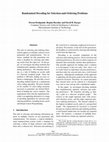Papers by Pawan Deshpande
In present day India, there is an obvious preference for light skin as evidenced by matrimonial a... more In present day India, there is an obvious preference for light skin as evidenced by matrimonial advertisements, media and cosmetics. Many scholars have attempted to attribute this phenomenon to a variety of sociological influences -- the theorized Aryan migration, the Islamic Conquest, or the British colonial rule of the subcontinent. This paper does not seek to determine the precise cause of it, but rather, it shows a dramatic shift in the perception of skin color in Indian society through the examination of historical scriptures and art.
This thesis focuses on developing decoding techniques for complex Natural Language Processing (NL... more This thesis focuses on developing decoding techniques for complex Natural Language Processing (NLP) tasks. The goal of decoding is to find an optimal or near optimal solution given a model that defines the goodness of a candidate. The task is challenging because in a typical problem the search space is large, and the dependencies between elements of the solution are complex.

The task of selecting and ordering infor- mation appears in multiple contexts in text generation ... more The task of selecting and ordering infor- mation appears in multiple contexts in text generation and summarization. For in- stance, methods for title generation con- struct a headline by selecting and order- ing words from the input text. In this pa- per, we investigate decoding methods that simultaneously optimize selection and or- dering preferences. We formalize decod- ing as a task of nding an acyclic path in a directed weighted graph. Since the problem is NP-hard, nding an exact so- lution is challenging. We describe a novel decoding method based on a randomized color-coding algorithm. We prove bounds on the number of color-coding iterations necessary to guarantee any desired likeli- hood of nding the correct solution. Our experiments show that the randomized de- coder is an appealing alternative to a range of decoding algorithms for selection-and- ordering problems, including beam search and Integer Linear Programming.
A method for automatic analysis of time-oriented clinical narratives would be of significant prac... more A method for automatic analysis of time-oriented clinical narratives would be of significant practical import for medical decision making, data modeling and biomedical research. This paper proposes a ro- bust corpus-based approach for temporal analysis of medical discharge summaries. We characterize tem- poral organization of clinical narratives in terms of temporal segments and their ordering. We consider a temporal segment
AMIA ... Annual Symposium proceedings / AMIA Symposium. AMIA Symposium, 2006
A method for automatic analysis of time-oriented clinical narratives would be of significant prac... more A method for automatic analysis of time-oriented clinical narratives would be of significant practical import for medical decision making, data modeling and biomedical research. This paper proposes a robust corpus-based approach for temporal analysis of medical discharge summaries. We characterize temporal organization of clinical narratives in terms of temporal segments and their ordering. We consider a temporal segment to be a fragment of text that does not exhibit abrupt changes in temporal focus. Our method derives temporal order based on a range of linguistic and contextual features that are integrated in a supervised machine-learning framework. Our learning method achieves 83% F-measure in tempo-ral segmentation, and 78.3% accuracy in inferring pairwise temporal relations.
Proceedings of the 2006 Conference on Empirical Methods in Natural Language Processing - EMNLP '06, 2006
Proc. Conference of the North American Chapter of the Association for Computational Linguistics on Human Language Technologies (NAACL HLT’07), 2007
The task of selecting and ordering information appears in multiple contexts in text generation an... more The task of selecting and ordering information appears in multiple contexts in text generation and summarization. For instance, methods for title generation construct a headline by selecting and ordering words from the input text. In this paper, we investigate decoding methods that simultaneously optimize selection and ordering preferences. We formalize decoding as a task of finding an acyclic path in a directed weighted graph. Since the problem is NP-hard, finding an exact solution is challenging. We describe a novel ...
This paper presents a method for the auto- matic generation of a table-of-contents. This type of ... more This paper presents a method for the auto- matic generation of a table-of-contents. This type of summary could serve as an effec- tive navigation tool for accessing informa- tion in long texts, such as books. To gen- erate a coherent table-of-contents, we need to capture both global dependencies across different titles in the table and local con- straints within sections. Our algorithm ef- fectively handles these complex dependen- cies by factoring the model into local and global components, and incrementally con- structing the model's output. The results of automatic evaluation and manual assessment confirm the benefits of this design: our sys- tem is consistently ranked higher than non- hierarchical baselines.









Uploads
Papers by Pawan Deshpande